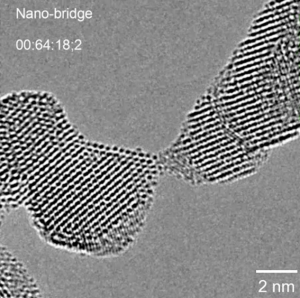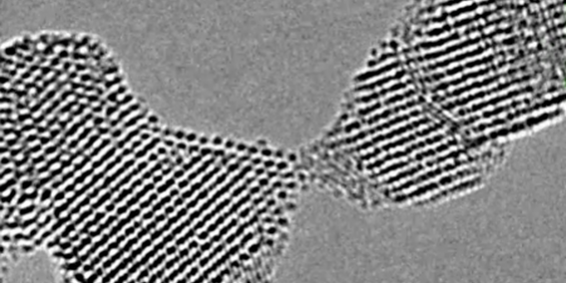Paper published in the journal Physical Review Letters highlights how state-of-the-art electron microscopy and computer simulations revealed unprecedented properties of zirconium dioxide
 The development of new technologies – whether faster and more efficient electronic devices, better catalysts for the chemical industry or alternative energy sources – increasingly depends on the detailed understanding of the behavior of materials at the atomic and molecular scale.
The development of new technologies – whether faster and more efficient electronic devices, better catalysts for the chemical industry or alternative energy sources – increasingly depends on the detailed understanding of the behavior of materials at the atomic and molecular scale.
However, when we go from macroscopic dimensions to nanometric dimensions (millionths of a millimeter), the electrical, magnetic, optical, or other properties of the materials can be completely different to those that the same material presents in its macroscopic version.
For this reason, the possibility of controlling the characteristics of materials on this tiny scale, which in addition to their composition also depend on their shape and size, opens the door to an immense variety of applications.
A bridge of atoms
Monoatomic nanowires are structures formed by a chain of atoms arranged so that their cross-section has only a single atom. They are the experimental realization of an ideal one-dimensional system and provide a way to study the physics of atoms and electrons confined in this dimension. The peculiar behavior of such extremely low-dimensional systems often reveals surprising and unexpected properties, such as changing from insulators to conductors or from magnetic to non-magnetic, among others.
“Experiments to produce monoatomic wires began with metallic atoms, particularly Gold (Au), Iridium (Ir) and Platinum (Pt), and covalent compounds such as carbon chains. On the other hand, wires made of ionic compounds, such as ceramics, had never been observed or experimentally produced until the atomic limit. These systems are generally fragile and therefore considered less likely to form such ultra-thin structures, compared to metals,” explains the director of the Brazilian Nanotechnology National Laboratory (LNNano), Rodrigo Capaz, one of the authors of the research.
Microscopy and Computational Simulations
The state-of-the-art transmission microscopy infrastructure and the computational skills available at the Brazilian Center for Research in Energy and Materials (CNPEM), were fundamental for the researchers to obtain zirconium dioxide (ZrO2) monoatomic nanowires in a pioneering way.
With one of the electron microscopes available at CNPEM, capable of making images of atoms with resolution of the order of tenths of nanometers, the researchers followed the movement of each atom in the system and the entire process of formation of nanowires.
“The group observed the formation of highly stable ionic monoatomic wires during the final stages of rupture between two ZrO2 nanoparticles placed in contact and subjected to mechanical stress to separate,” explains Capaz.
Usually brittle in its macroscopic form, zirconium dioxide, also known as zirconia, is a material widely used in catalysts, LEDs, lithium-ion batteries, and biomedical applications, among others. However, in this monoatomic nanowire form, ZrO2 presents new mechanical properties, moving to a ductile and malleable state.
The results, published in the journal Physical Review Letters, are a step forward towards a better understanding of the mechanical properties of ionic materials at the nanoscale, and pave the way for further investigations and applications of the unique mechanical properties of these systems.
In support of the experimental findings, computational simulations of the molecular dynamics of the studied material were performed. These extremely sophisticated calculations, performed with the help of CNPEM’s computing infrastructure, simulate the behavior of a set of atoms under the same conditions used in microscopy experiments.
However, these simulations not only serve to reproduce what was observed in the microscopy experiments, they also reveal the process and which atoms are responsible for the formation of the monoatomic wire and the new mechanical properties of the material.
Theory Groups
The work involves collaboration between two of CNPEM’s research and development areas: Enabling Technologies for Electron Microscopy, and Theory and Data Science. The latter brings together researchers working in molecular dynamics simulations, electronic structure and electronic transport calculations, machine learning, among others, with the aim of advancing the state-of-the-art of these techniques and providing theoretical and computational support for experimental activities developed throughout CNPEM.
About CNPEM
Sophisticated and effervescent environment for research and development, unique in Brazil and present in few scientific centers in the world, the Brazilian Center for Research in Energy and Materials (CNPEM) is a private non-profit organization, under the supervision of the Ministry of Science, Technology and Innovations (MCTI). The Center operates four National Laboratories and is the birthplace of the most complex project in Brazilian science – Sirius – one of the most advanced synchrotron light sources in the world. CNPEM brings together highly specialized multi-thematic teams, globally competitive laboratory infrastructures open to the scientific community, strategic lines of investigation, innovative projects in partnership with the productive sector and training of researchers and students. The Center is an environment driven by the search for solutions with impact in the areas of Health, Energy and Renewable Materials, Agro-environment, and Quantum Technologies. As of 2022, with the support of the Ministry of Education (MEC), CNPEM expanded its activities with the opening of the Ilum School of Science. The interdisciplinary higher course in Science, Technology and Innovation adopts innovative proposals with the aim of offering excellent, free, full-time training with immersion in the CNPEM research environment.


